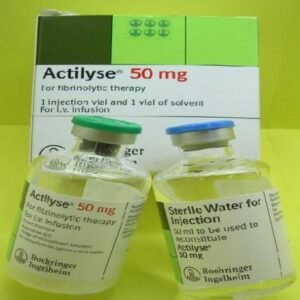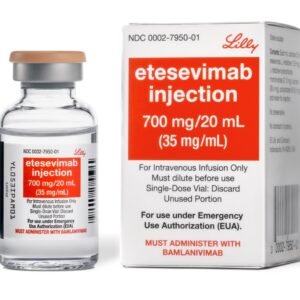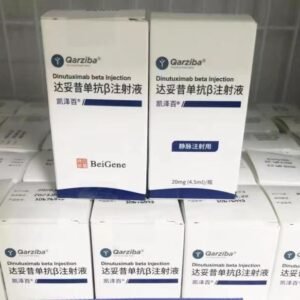Alteplase for Injection.
Effects and efficacy:
For the treatment of acute myocardial infarction, for patients with symptoms within 6 hours of onset, a 90-minute accelerated administration method can be used. For patients with a clear diagnosis within 6-12 hours of symptom onset, a 3-hour administration method can be used. For the treatment of acute large-area pulmonary embolism with unstable blood flow, objective means should be used to confirm the diagnosis when possible, such as pulmonary angiography or non-invasive means such as lung scanning. For the treatment of acute ischemic stroke, appropriate imaging examinations must be performed in advance to exclude intracranial hemorrhage, and treatment should be performed within 3 hours after the onset of acute ischemic stroke symptoms. It can be used for artificial heart valve thrombosis. It can be used to clear central venous catheter thrombosis. It can be used for microvascular thrombosis. It is used to treat fibrin deposits that may form after surgery, such as cataract or glaucoma surgery, including pediatric cataracts. It can be used for peripheral arterial thromboembolism. It can prevent hemodialysis central venous catheter occlusion.
Dosage and Administration:
The conventional dosage for injection in adults is as follows: Accelerated infusion method: ① Over 67kg: 100mg as a 15mg intravenous push, followed by 50mg in the next 30 minutes, and then 35mg in the next 60 minutes. ② Under 67kg: 15mg intravenous push, followed by 0.75mg/kg (not to exceed 50mg) in the next 30 minutes, and then 0.5mg/kg (not to exceed 35mg) in the next 60 minutes. 3-hour infusion method: ① Over 65kg: 100mg intravenously at 60mg in the first hour (6 to 10mg given as an intravenous push within 1 to 2 minutes), and then intravenously at a rate of 20mg/hour in the 2nd and 3rd hours. ② Less than 65kg: 1.25mg/kg intravenously at a dose of 0.75mg/kg in the first hour (6 to 10mg given as an intravenous push within 1 to 2 minutes), followed by 0.25mg/kg/hour in the hours. Heparin is usually given during and after alteplase administration. ST-segment elevation myocardial infarction: ① Full-dose administration: On the basis of intravenous heparinization, alteplase 15 mg is injected intravenously, followed by 0.75 mg/kg continuous intravenous drip within 30 minutes (maximum dose is 50 mg), followed by 0.5 mg/kg continuous intravenous drip within 60 minutes (maximum dose is 35 mg). ② Half-dose administration: On the basis of intravenous heparinization, 50 mg of alteplase is dissolved in 50 ml of special solvent, 8 mg is injected intravenously first, and the remaining 42 mg is intravenously dripped within 90 minutes. 10 mg is pushed intravenously within 1-2 minutes, and 90 mg is continuously dripped intravenously for the next 2 hours. For patients weighing less than 65 kg, the total dose should not exceed 1.5 mg/kg body weight. The recommended dose is 0.9 mg/kg body weight (maximum dose is 90 mg), 10% of the total dose is first pushed intravenously, and the remaining dose is continuously dripped intravenously for the next 60 minutes. Treatment should be started within 3 hours after the onset of symptoms. Manufacturer’s recommendations Patients 30 kg or more: 2 mg/2 mL; if the catheter is still blocked after a 2-hour dwell time, a second dose may be instilled. A recent study using escalating doses of 0.5 mg, 1 mg, and 2 mg (with a 60-minute dwell time) found that 86.2% of catheters were cleared with the 0.5 mg dose.
Adverse Reactions:
Common adverse reactions Bleeding from puncture sites and wounds, bleeding gums, coughing up blood, difficulty breathing or swallowing, dizziness, headache, increased menstrual or vaginal bleeding, nosebleeds, numbness, prolonged bleeding from wounds, red or black, tarry stools, red or dark brown urine Rare adverse reactions Chills, fainting, rapid heartbeat, fever, dizziness, pain in the chest, groin, or legs, especially in the calves, pain in the arms or legs, redness, swelling, rapid, shallow breathing, severe, sudden headache, slurred speech, sudden loss of coordination, sudden, severe weakness or numbness in the arms or legs, unexplained shortness of breath, vision changes. Serious adverse reactions Cardiovascular system: arrhythmia, cardiac tamponade, laceration-injury, cardiac rupture, pericardial effusion, pericarditis; Gastrointestinal: gastrointestinal bleeding (5%); Hematological system: bleeding; Immune system: hypersensitivity; Nervous system: brain herniation, cerebrovascular accident (1.6%), intracranial hemorrhage (0.4%-1.3%), ischemic stroke, convulsions; Respiratory system: pleural effusion, pulmonary edema; Other: oral and tongue angioedema. Adverse reaction management Angioedema: Oral and tongue angioedema has been reported in patients with ischemic stroke or myocardial infarction. Monitoring is recommended. If the above symptoms occur, discontinue the drug. Hematological system: If other anticoagulants are used at the same time, close monitoring for bleeding is required, especially at the arterial puncture site. If severe bleeding occurs, discontinue the drug. Severe internal bleeding or fatal internal bleeding (i.e., intracranial, retroperitoneal, gastrointestinal, genitourinary system, respiratory system), or external bleeding has been reported; if severe bleeding occurs, discontinue use. Severe bleeding in important organs may occur; discontinue use. Blood system: Due to the increased risk of bleeding, arterial and venous punctures should be minimized; if severe bleeding occurs, discontinue use.
Drug contraindications:
Allergic to this product is prohibited. Use with caution during lactation. Use with caution during pregnancy.
Share:
Products
Our offers
Health Classification
Let us work together to protect precious health
































